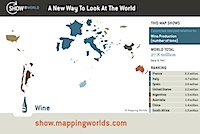That’s the cheesy title of what should be a fascinating National Geographic documentary on a subject that we’ve covered here a number of times: the idea that the Amazon was once thickly settled. If anyone sees it, do let us know what it’s like.
Fishy facts
Myself, I’d rather eat wild cod once a month and sardines once a week than farm-raised salmon, ever.
Me too.
Well, not too often.
Warm blooded, acrobatic, long-lived, and wily, it’s a miracle of evolution.
But that shouldn’t stop us doing what we like to it, right?
Mine’s a decaff
We’re always on the look-out for examples of the financial value of germplasm collections which don’t involve some obscure and faraway disease, however nasty. So it was really nice to come across a great story about the search for naturally low-caffeine coffee, and in the Wall Street Journal no less. Coincidentally, there was also a blog post yesterday about the wild coffees of Madagascar. 1 Some of the many species found on that island are known to have low caffeine levels, but “[a]ttempts to transfer the caffeine-free property from wild coffee species of Madagascar, which produce an inferior beverage, to C. arabica have failed owing to a strong genetic barrier.”
LATER: I wonder if the recent Korean “land-grab” in Madagascar will have an effect on wild coffees and other interesting endemics.
Map THIS
Resilience Science points to a new source of cartograms at ShowWorld, a project of Mapping Worlds. These maps, which display a metric by manipulating the sizes of the various countries displayed, are a wonderful way to bring boring old data to life, and an even better way to fill an empty hour or two. What I really want, though, is a way to mash two data sources. Resilience Sciences selects carbon dioxide emissions and pig populations. Great, and just looking at the maps I have a strong impression that there’s no correlation between number of pigs and carbon dioxide emitted. But is that really true? Enquiring minds want to know. Some genius should figure out a way of doing x per y in a cartogram.
Here, though, we have Wine and Cheese, which were meant to go together, and more or less do, which is nice.
2nd World Congress of Agroforestry 3rd Announcement
This just in.
Theme: Agroforestry – The Future of Global Land Use
The Congress will assess opportunities to leverage scientific agroforestry in promoting sustainable land use worldwide. It will also serve as a forum for agroforestry researchers, educators, practitioners and policy makers from around the world to:
- share new research findings, lessons, experiences, and ideas that will help influence decisions that impact on livelihoods and the global environment
- explore new opportunities and strengthen existing partnerships in agroforestry research, education, training, and development
- form new networks and communities of practice, and nurture old ones

